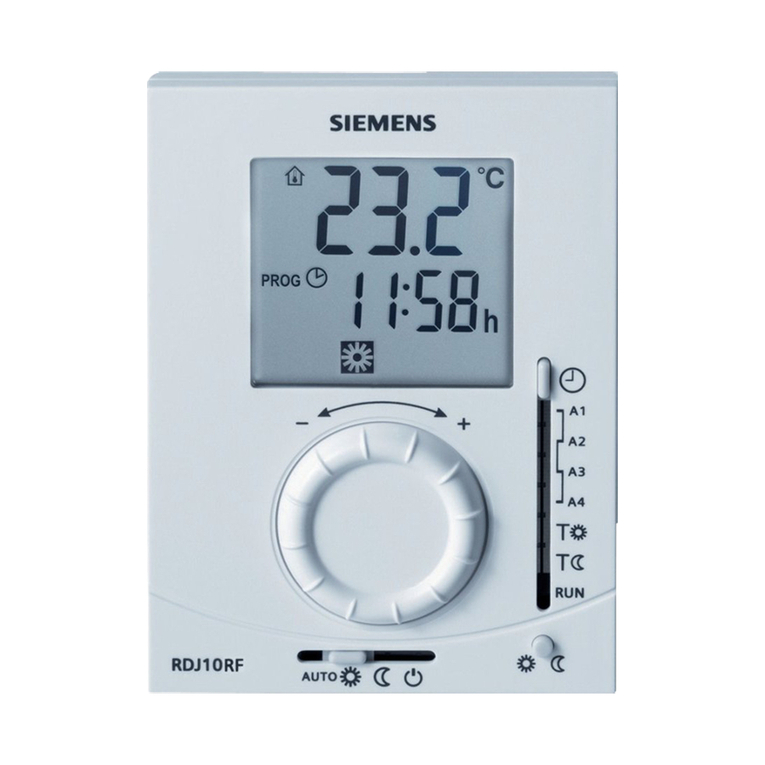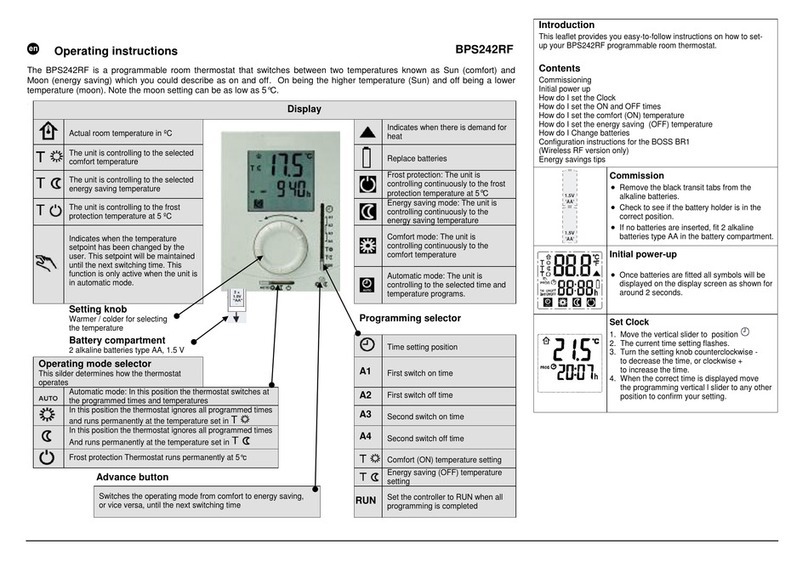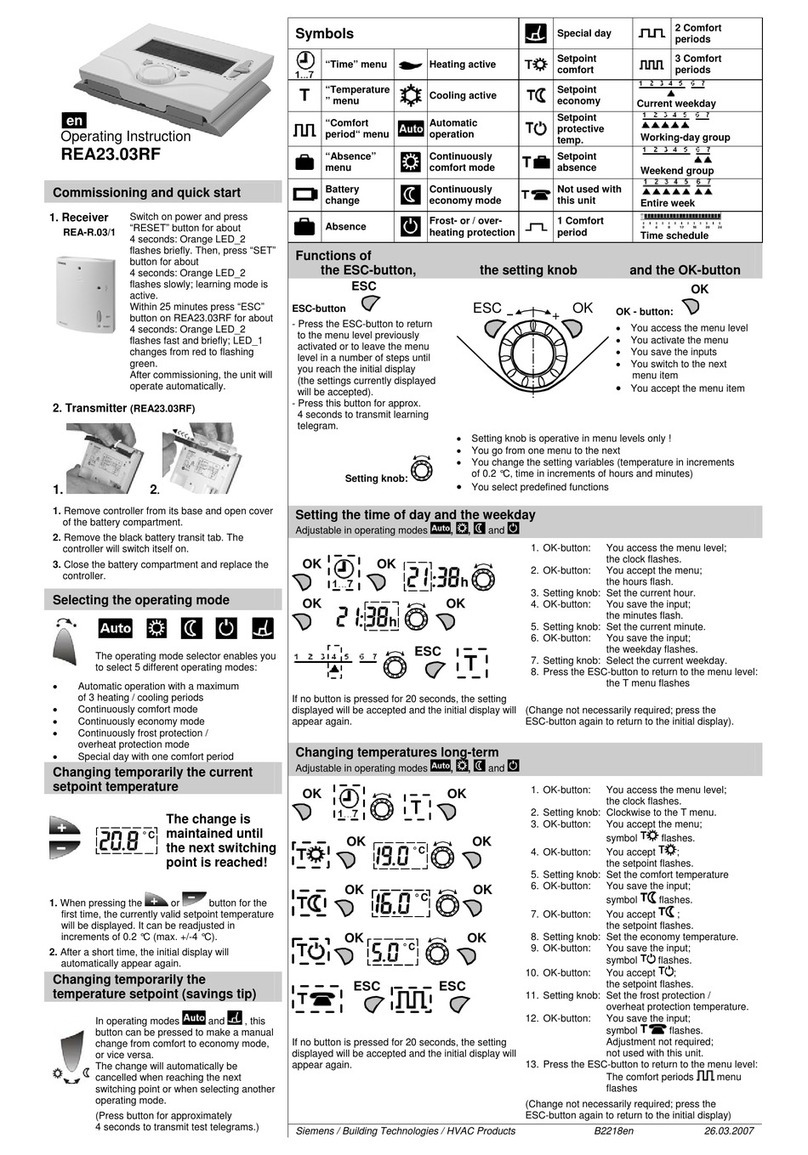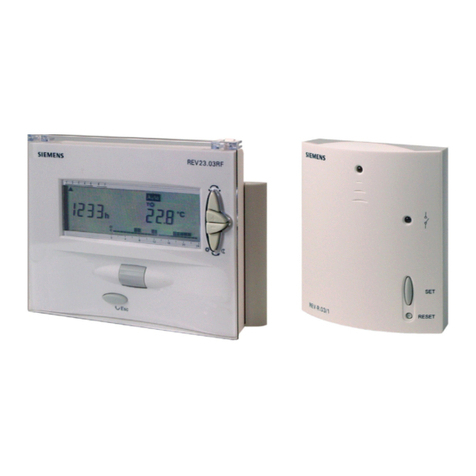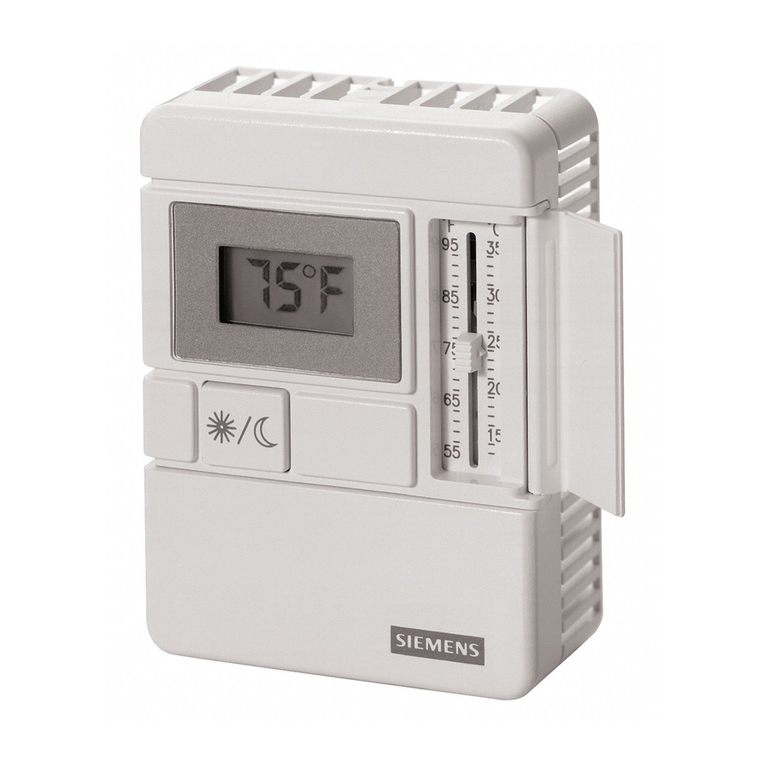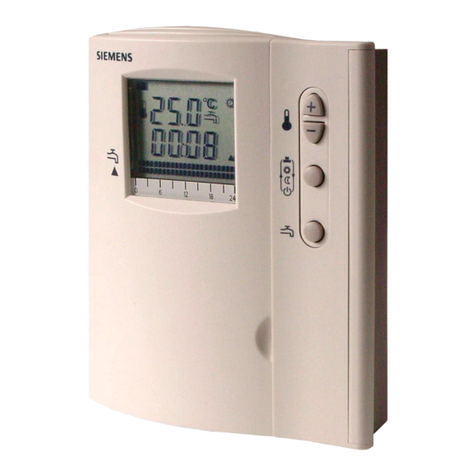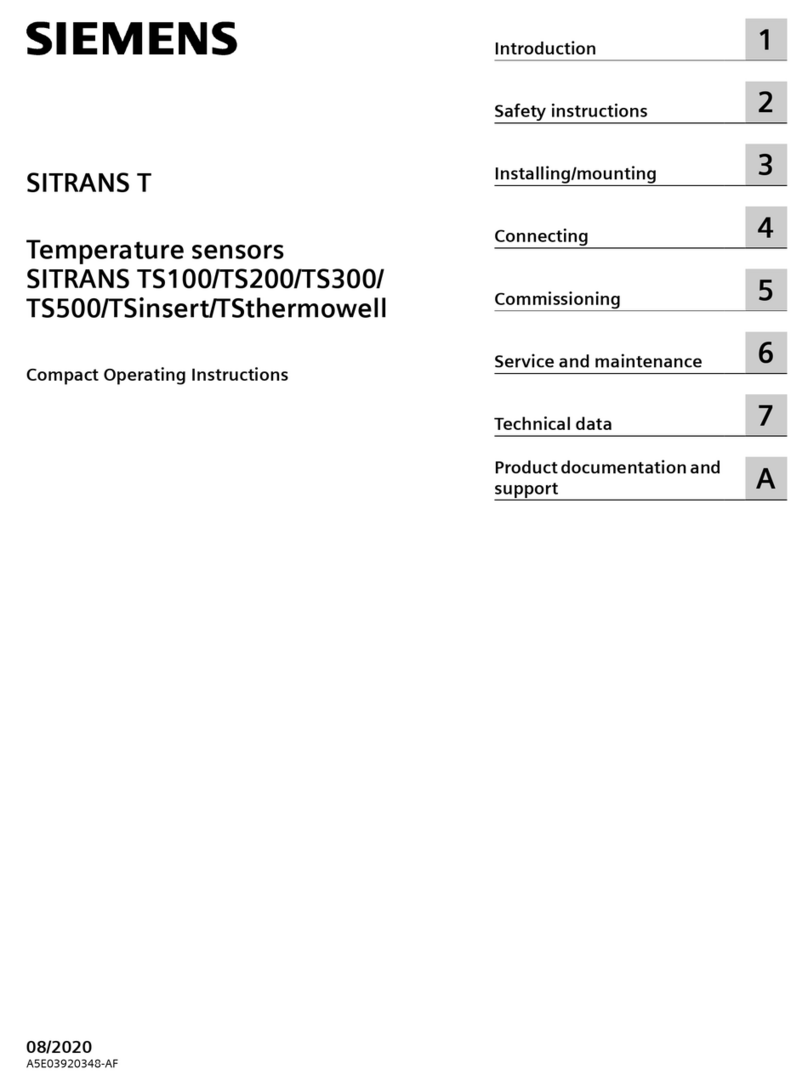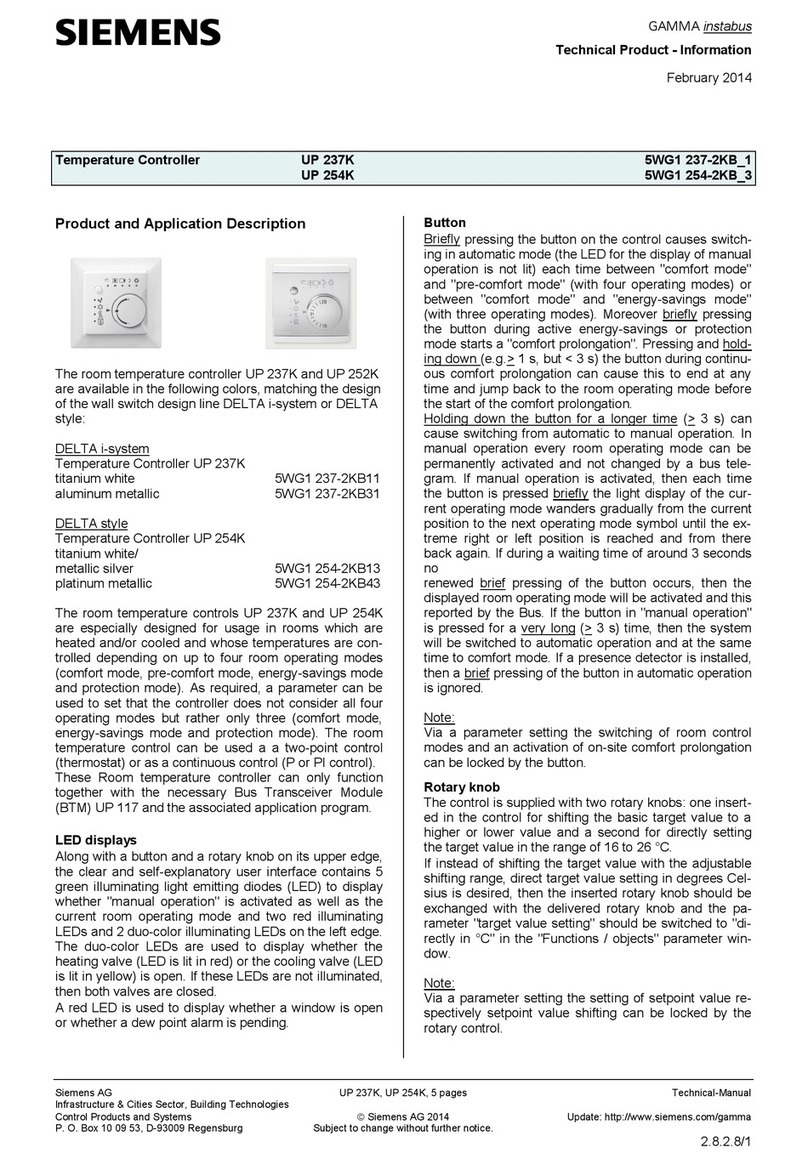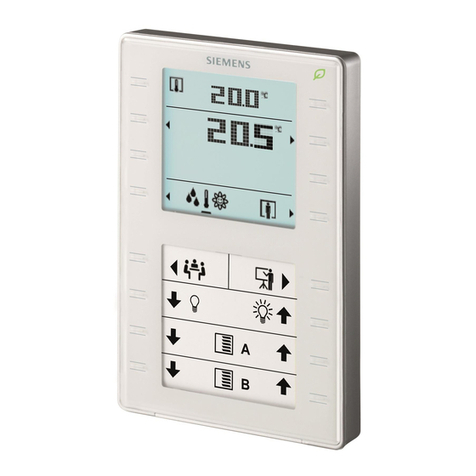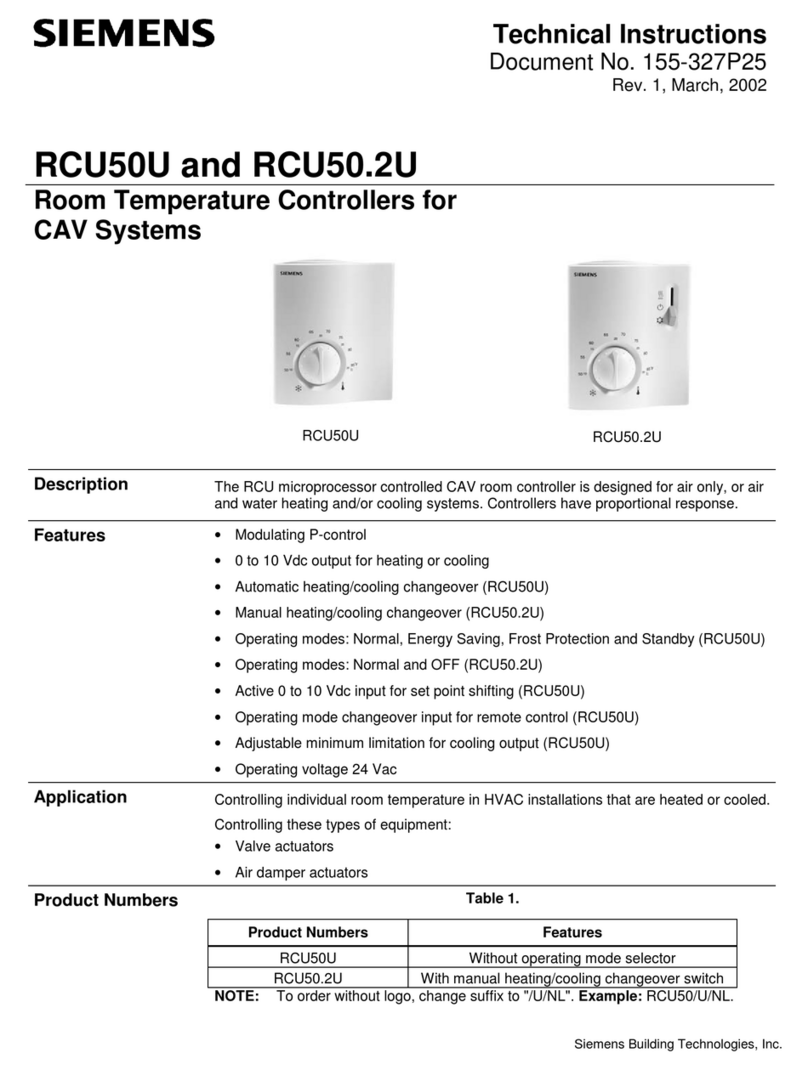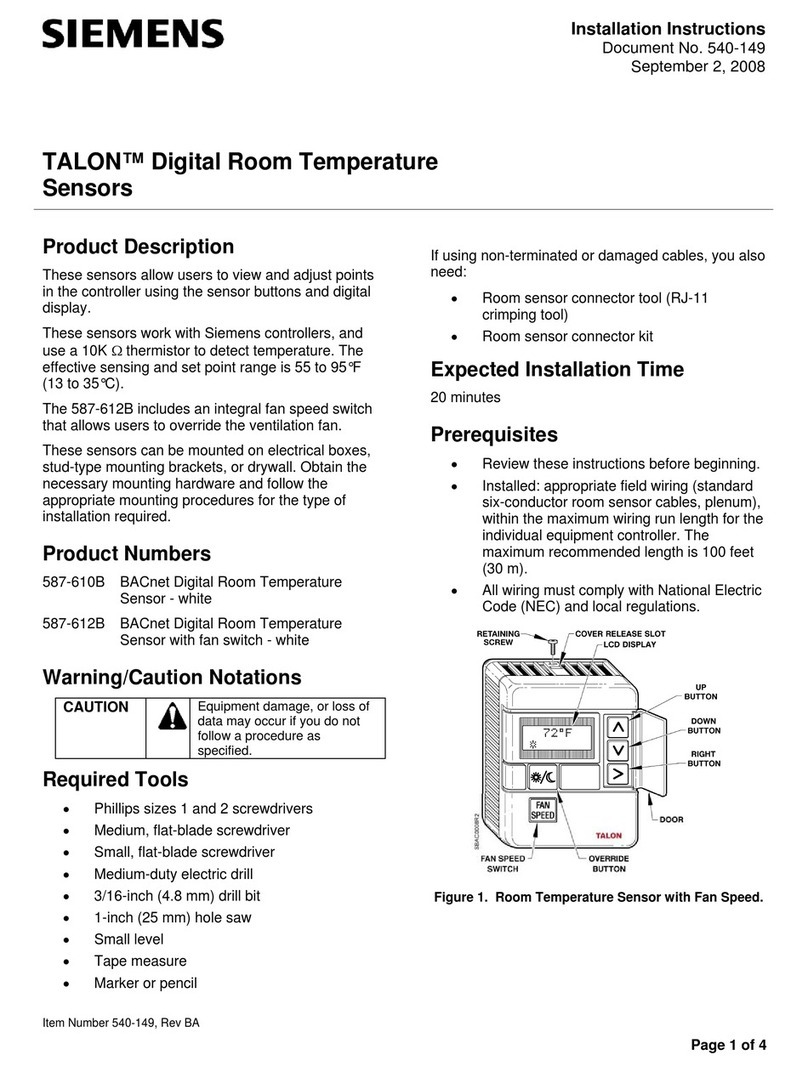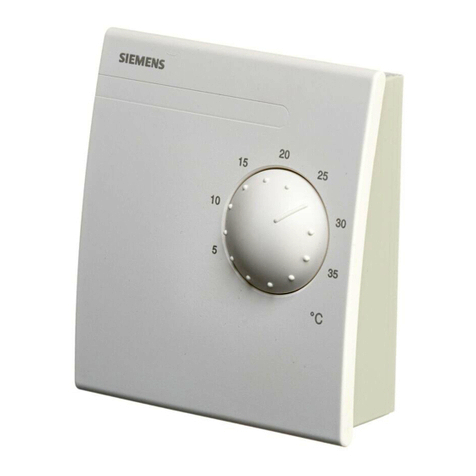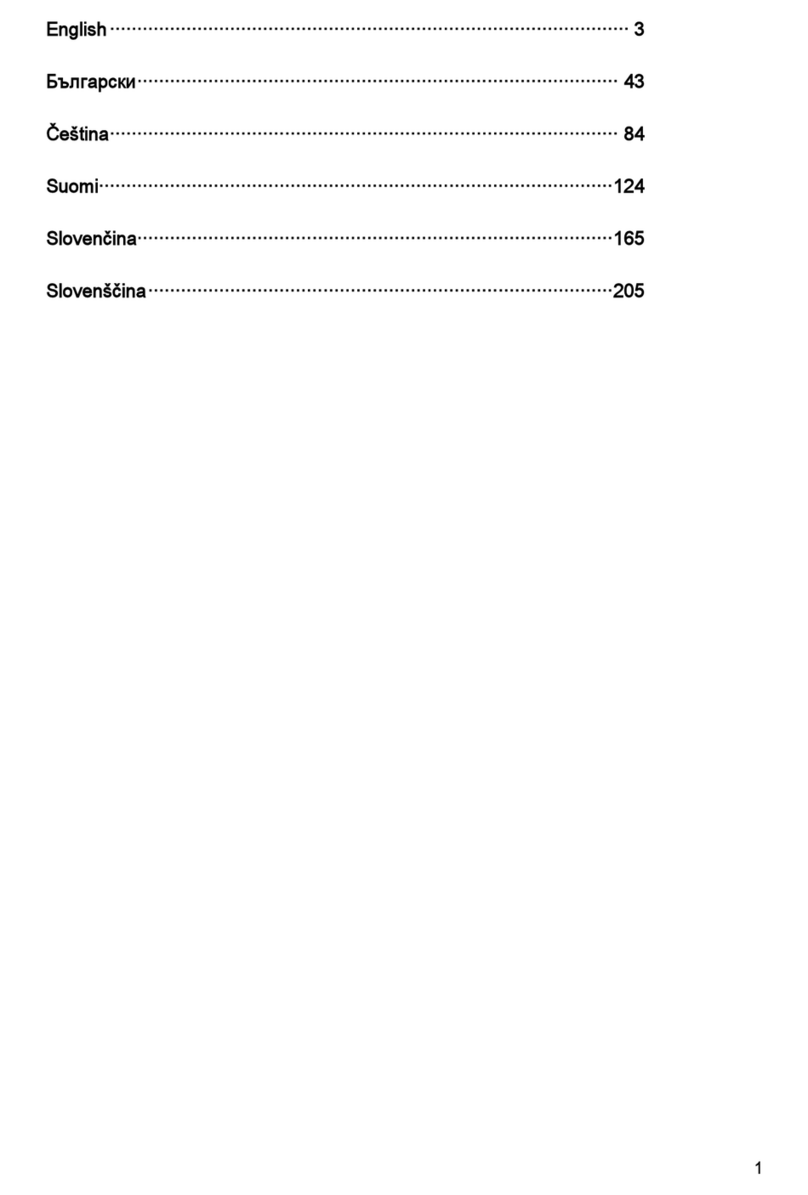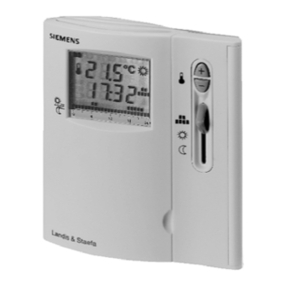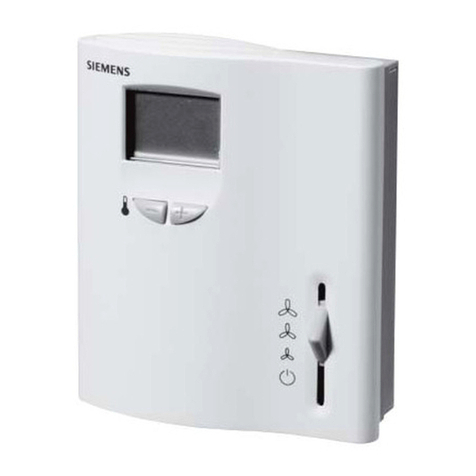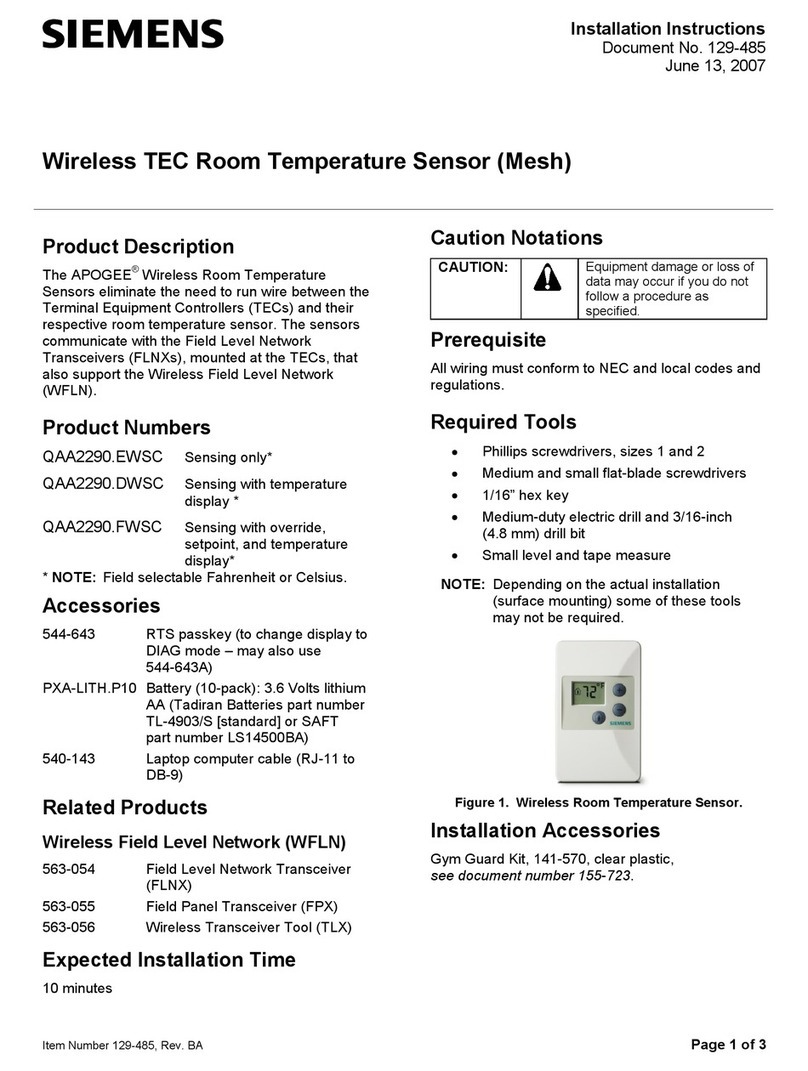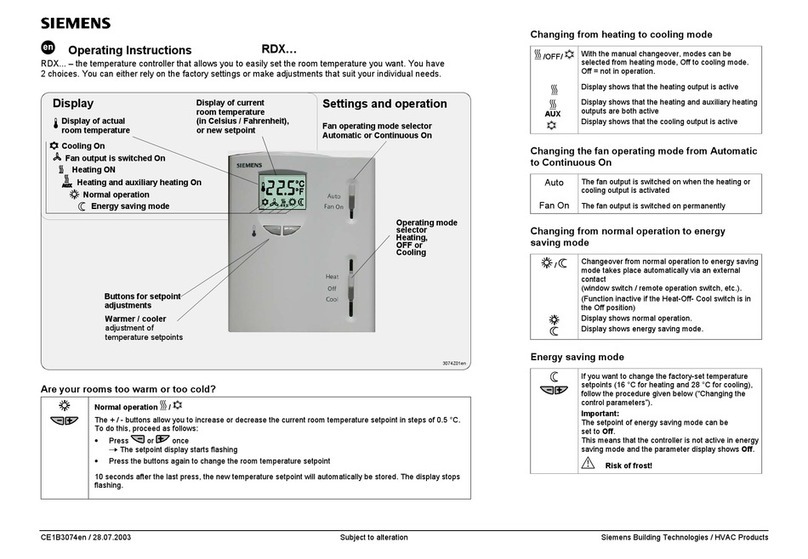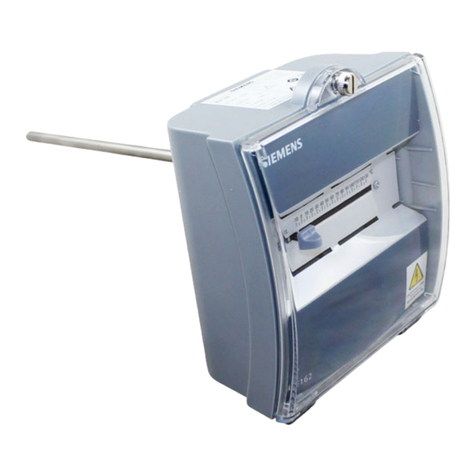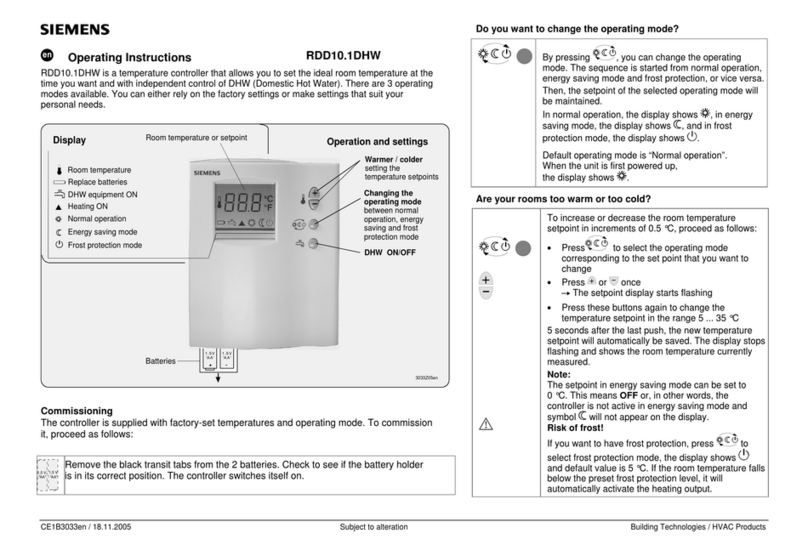
A5E02926638A DS03 Seite 1 von 3 page 1 of 3
GAMMA instabus
isystem
Raumtemperaturregler UP 237K
Temperature controller UP 237K
titanweiß/titanium white 5WG1 23 2KB11
aluminiummetallic/
aluminum metallic 5WG1 23 2KB31
DELTA style
Raumtemperaturregler UP 2 4K
Temperature controller UP 2 4K
titanweiß/metallicsilber
titanium white/metallic silver 5WG1 2542KB13
platinmetallic/
platinum metallic 5WG1 2542KB43
Bedien und Montageanleitung
Operating and Mounting Instruction
Stand: August 2012
Issued: August 2012
Bild 1: Raumtemperaturregler mit Drehknopf zur
Sollwerteinstellung in °C
Figure 1: : Room temperature controller with rotary
knob for setting the setpoint value in °C
Bild 2: Raumtemperaturregler mit Drehknopf
zur Sollwertverschiebung
Figure 2: Room temperature controller with rotary
knob for shifting the setpoint value
Produkt und Funktionsbeschreibung
Die Raumtemperaturregler UP 23 K und UP 254K sind speziell
für den Einsatz in Räumen ausgelegt, die geheizt und / oder ge
kühlt werden und deren Raumtemperaturregelung abhängig von
bis zu vier RaumBetriebsarten (Komfortbetrieb, Pre
Komfortbetrieb, Energiesparbetrieb und Schutzbetrieb) erfolgt.
Über einen Parameter ist bei Bedarf einstellbar, dass der Regler
nicht alle vier Betriebsarten berücksichtigen soll sondern nur drei
(Komfortbetrieb, Energiesparbetrieb und Schutzbetrieb) oder nur
zwei (Komfortbetrieb und Schutzbetrieb). Der
Raumtemperatur
regler
ist
als Zweipunktregler (Thermostat) oder als stetiger Reg
ler (P, PIRegler) einsetzbar.
Das zugehörige Applikationsprogramm vergleicht die vom Raum
temperaturregler gemessene IstTemperatur mit der gewünsch
ten SollTemperatur und berechnet daraus die zugehörige Stell
größe. Diese wird dann entweder als Schaltbefehl (Ein/Aus) an
Schaltaktoren zum Ansteuern von elektrothermischen Stellan
trieben bei einer Zweipunktregelung oder als Stellbefehl (0...
100 %) zum Ansteuern eines motorisch angetriebenen Ventil
stellantriebes bei stetiger Regelung übertragen.
Diese Raumtemperaturregler sind nur zusammen mit einem Bus
Transceiver Module (BTM) UP 11 und dem zugehörigen Appli
kationsprogramm einsetzbar.
LEDAnzeigen
Die übersichtliche und selbsterklärende Bedienoberfläche ent
hält außer einem Taster und einem Drehknopf an ihrem oberen
Rand 5 grün leuchtende Leuchtdioden (LED) zur Anzeige, ob der
„Handbetrieb“ aktiviert ist sowie der aktuellen RaumBetriebsart
und am linken Rand der Bedienoberfläche zwei rot leuchtende
LED`s und 2 zweifarbig leuchtende LED`s . Die zweifarbigen
LED`s werden zur Anzeige, ob das Heizventil geöffnet ist (LED
leuchtet rot) oder das Kühlventil (LED leuchtet gelb) geöffnet ist,
verwendet. Leuchten diese LED`s nicht, so sind beide Ventile
geschlossen.
Über je eine rote LED wird angezeigt, ob ein Fenster geöffnet ist
oder ein Taupunktalarm ansteht.
Taster
Durch kurzes Betätigen des Tasters auf dem Regler erfolgt im Au
tomatikbetrieb (die LED zur Anzeige des Handbetriebs leuchtet
nicht) die Umschaltung jeweils zwischen „Komfortbetrieb“ und
„PreKomfortbetrieb“ (bei vier Betriebsarten) bzw. zwischen
„Komfortbetrieb“ und „Energiesparbetrieb“ (bei drei Betriebsar
ten). Außerdem kann durch ein kurzes Drücken bei aktivem
Energiespar oder Schutzbetrieb eine „KomfortVerlängerung“
gestartet werden. Durch ein langes (z.B. > 1 s, aber < 3 s) Drü
cken des Tasters während einer laufenden KomfortVerlängerung
kann
diese jederzeit beendet und auf die Raumbetriebsart vor Beginn
der KomfortVerlängerung zurückgesprungen werden.
Durch sehr langes (> 3 s) Betätigen des Tasters kann von Auto
matik auf Handbetrieb umgeschaltet werden. Im Handbetrieb
kann jede RaumBetriebsart dauerhaft aktiviert und nicht durch
ein BusTelegramm geändert werden. Ist der Handbetrieb akti
viert, so wandert bei jeder kurzen Betätigung des Tasters die
Leuchtanzeige der aktuellen Betriebsart von der aktuellen Positi
on schrittweise zum jeweils nächsten BetriebsartSymbol, bis die
äußerste rechte oder linke Position erreicht ist und von dort wie
der zurück. Erfolgt während einer Wartezeit von ca. 3 Sekunden
keine
erneute kurze TasterBetätigung, so wird die angezeigte Raum
Betriebsart aktiviert und dies über den Bus gemeldet. Wird der
Taster im „Handbetrieb“ sehr lange (> 3 s) betätigt, so wird hier
durch auf Automatikbetrieb und gleichzeitig auf Komfortbetrieb
umgeschaltet. Ist ein Präsenzmelder installiert, so wird ein kur
zes Betätigen des Tasters im Automatikbetrieb ignoriert.
Drehknopf
Der Regler wird mit zwei Drehknöpfen geliefert: einem in den
Regler gesteckten Drehknopf zum Verschieben des Basis
Sollwertes (siehe Bild 2) zu einem höheren bzw. niedrigeren
Wert und einem zweiten zum direkten Einstellen des Sollwertes
(siehe Bild 1) im Bereich von 16 bis 26 °C.
Wird anstelle der SollwertVerschiebung mit einstellbarem Ver
schiebebereich die direkte SollwertEinstellung in Grad Celsius
gewünscht, so ist der eingesteckte gegen den mitgelieferten
Drehknopf auszuwechseln und im ParameterFenster „Funktio
nen / Objekte“ der Parameter „SollwertEinstellung“ auf „direkt in
°C“ zu setzen.
Inbetriebnahme
Zur Inbetriebnahme eines Reglers mit Hilfe der ETS (Engineering
Tool Software) ist der Regler zuvor zusammen mit dem passen
den DELTA Rahmen auf ein Bus Transceiver Module (BTM) UP
11 zu stecken, das zur Stromversorgung des Reglers und zur
Datenübertragung über den KNXBus dient.
Nach Abziehen des Drehknopfes zur SollwertVerschiebung wer
den die Aussparungen für den InbetriebnahmeTaster und die
InbetriebnahmeLED des Reglers sichtbar.
Hinweis: Das Bus Transceiver Modul UP 11 und der zugehörige
DELTA Rahmen sind nicht im Lieferumfang enthalten und müs
sen zusätzlich bestellt werden.
Weitere Informationen
http://www.siemens.de/gamma
GB
Product and Applications Description
The room temperature controller UP 23 K and UP 254K are es
pecially designed for usage in rooms which are heated and/or
cooled and whose temperatures are controlled depending on up
to four room operating modes (comfort mode, precomfort
mode, energysavings mode and protection mode). As required,
a parameter can be used to set that the controller does not con
sider all four operating modes but rather only three (comfort
mode, energysavings mode and protection mode). The
room
temperature controller
can be used
as a twopoint control (ther
mostat) or as a continuous controller (P or PI controller).
The associated application program compares the actual tem
perature measured by the temperature controller with the re
quired setpoint temperature and calculates the relevant control
value. This control value is then either transmitted as a switching
command (ON/OFF) to switch actuators to control electrother
mal valve drives in twostep control or as a control command
(0... 100 %) for controlling a motordriven valve drive in con
tinuous control.
These Room temperature controller can only function together
with the necessary Bus Transceiver Module (BTM) UP 11 and
the associated application program.
LED displays
Along with a button and a rotary button on its upper edge, the
clear and selfexplanatory user interface contains 5 green illumi
nating light emitting diodes (LED) to display whether "manual
operation" is activated as well as the current room operating
mode and two red illuminating LEDs and 2 duocolor illuminating
LEDs on the left edge. The duocolor LEDs are used to display
whether the heating valve (LED is lit in red) or the cooling valve
(LED is lit in yellow) is open. If these LEDs are not illuminated,
then both valves are closed.
A red LED is used to display whether a window is open or
whether a dew point alarm is pending.
Button
Briefly pressing the button on the controller causes switching in
automatic mode (the LED for the display of manual operation is
not lit) each time between "comfort mode" and "precomfort
mode" (with four operating modes) or between "comfort mode"
and "energysavings mode" (with three operating modes). More
over briefly pressing the button during active energysavings or
protection mode starts a "extended comfort mode". Pressing and
holding down (e.g.> 1 s, but < 3 s) the button during continuous
extended comfort mode can cause this to end at any time and
jump back to the room operating mode before the start of the
extended comfort mode.
Holding down the button for a longer time (> 3 s) can cause
switching from automatic to manual operation. In manual opera
tion every room operating mode can be permanently activated
and not changed by a bus telegram. If manual operation is acti
vated, then each time the button is pressed briefly the light dis
play of the current operating mode wanders gradually from the
current position to the next operating mode symbol until the ex
treme right or left position is reached and from there back again.
If during a waiting time of around 3 seconds no
renewed brief pressing of the button occurs, then the displayed
room operating mode will be activated and this reported by the
Bus. If the button in "manual operation" is pressed for a very long
(> 3 s) time, then the system will be switched to automatic op
eration and at the same time to comfort mode. If a presence de
tector is installed, then a brief pressing of the button in auto
matic operation is ignored.
Rotary button
The controller is supplied with two rotary buttons: one inserted
in the controller for shifting the basic setpoint (see figure 2)
value to a higher or lower value and a second for directly setting
the setpoint value (see figure 1) in the range of 16 to 26 °C.
If instead of shifting the setpoint value with the adjustable shift
ing range, direct setpoint value setting in degrees Celsius is de
sired, then the inserted rotary button should be exchanged with
the delivered rotary button and the parameter "setpoint value
setting" should be switched to "directly in °C" in the "Functions /
objects" parameter window.
Commissioning
For commissioning a controller with the help of ETS (Engineering
Tool Software), the controller together with the suitable DELTA
frame must first be inserted into a Bus Transceiver Module (BTM)
UP 11 which serves to supply power to the control and to
transmit data via the KNX Bus.
After removing the rotary button for setpoint value shifting, the
recess for the commissioning button and the commissioning LED
of the control are visible.
Note: The bus transceiver module UP 11 and the associated
DELTA frame are not supplied and must be ordered separately.
Additional Information
http://www.siemens.com/gamma
